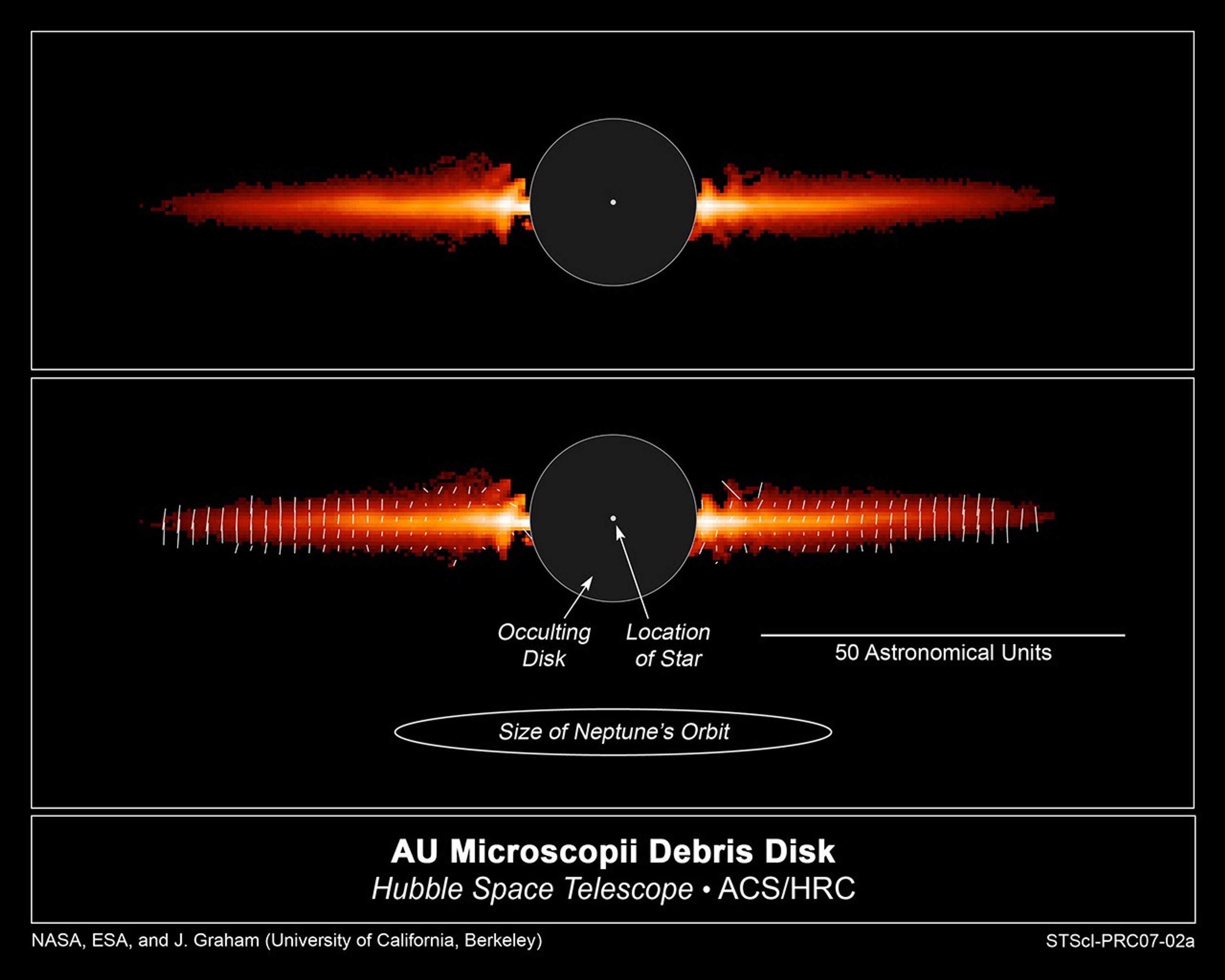1 min read
Hubble’s Snapshot of Debris Disk Around Young Star

The top view, taken with NASA's Hubble Space Telescope, shows light reflected off dust in a debris disk around the young star AU Microscopii. The bottom frame points out the important features in this image.
The image shows the flattened disk, appearing like Saturn's rings, but seen almost exactly edge-on. Normally, starlight would be so bright that the debris disk could not be seen. But astronomers used the coronagraph on Hubble's Advanced Camera for Surveys, which blocked out most of the starlight. The black circle in the center of the image is the coronagraph's occulting disk. The disk in this image extends to about 8 billion miles from the star, or three times farther than Neptune is from the Sun. In other observations, the disk has been traced to at least 11 billion miles.
The only light seen is starlight reflected off dust in the debris disk. Astronomers used polarizing filters on the Advanced Camera to analyze the dust in the disk. The polarizing filters allowed astronomers to study how dust is reflecting the starlight. A polarizing filter lets through light vibrating in one orientation while blocking light oscillating in other directions. The white lines in the bottom image illustrate the direction a light wave is oscillating. The length of the line represents the degree to which all the light waves are oscillating in the same direction.
The astronomers used the polarized light from AU Microscopii's disk to deduce information about the size, shape, and other physical properties of the dust. Astronomers used the polarization study to measure the fluffiness of the dust. The dust is roughly 10 times larger than typical interstellar dust grains, which are about the size of smoke particles. These "snowflakes" are evidence of the early steps in the process by which planets grow from tiny dust grains.
AU Microscopii is a 12-million-year-old red dwarf star that is 32 light-years away in the southern constellation the Microscope. It is a ninth magnitude star that can be seen with binoculars or a small telescope from Hawaii and the southern U.S.
The Hubble image was taken Aug. 1, 2004.
About the Object
- R.A. PositionR.A. PositionRight ascension – analogous to longitude – is one component of an object's position.20h 45m 9.53s
- Dec. PositionDec. PositionDeclination – analogous to latitude – is one component of an object's position.-31° 20' 27.19"
- ConstellationConstellationOne of 88 recognized regions of the celestial sphere in which the object appears.Microscopium
- DistanceDistanceThe physical distance from Earth to the astronomical object. Distances within our solar system are usually measured in Astronomical Units (AU). Distances between stars are usually measured in light-years. Interstellar distances can also be measured in parsecs.Approximately 33 light-years (10 parsecs).
- DimensionsDimensionsThe physical size of the object or the apparent angle it subtends on the sky.This image is 16 arcseconds (160 Astronomical Units) across.
About the Data
- Data DescriptionData DescriptionProposal: A description of the observations, their scientific justification, and the links to the data available in the science archive.
Science Team: The astronomers who planned the observations and analyzed the data. "PI" refers to the Principal Investigator.This image was created from HST data from the following proposal 10228: P. Kalas, J. Graham, and B. Matthews (University of California, Berkeley). - InstrumentInstrumentThe science instrument used to produce the data.HST>ACS/HRC
- Exposure DatesExposure DatesThe date(s) that the telescope made its observations and the total exposure time.August 1, 2004
- FiltersFiltersThe camera filters that were used in the science observations.F606W (V) (POL0V, POL60V, and POL120V)
- Object NameObject NameA name or catalog number that astronomers use to identify an astronomical object.AU Microscopii, AU Mic, GJ 803, HD197481
- Object DescriptionObject DescriptionThe type of astronomical object.Spectral Type "M0" Star with Debris Disk
- Release DateJanuary 7, 2007
- Science ReleaseHubble Observations Provide Insight into Planet Birth
- Credit

This image is representatively colored in a heat map color scheme. This image is a composite of many separate exposures made by the ACS/HRC instrument on the Hubble Space Telescope. Exposures were made through a filter sampling a broad range of wavelengths plus three separate polarizing filters with angles of polarization at 0°, 60° and 120°. The exposures have been combined into a single monochromatic image with brightness values mapped to a sequence of colors.

Related Images & Videos

Birth Ring of Debris Around AU Microscopii (AU Mic)
This is an artist's concept of the birth ring of debris encircling the 12-million-year-old star AU Microscopii. Porous, snowball-sized bodies collide within the birth ring. Stellar winds disperse dust grains away from the star beyond the birth ring to the outer debris disk.
Share
Details
Claire Andreoli
NASA’s Goddard Space Flight Center
Greenbelt, Maryland
claire.andreoli@nasa.gov






























